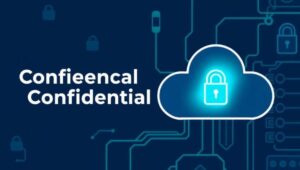Confidential Computing: Protecting Data in Use in the Cloud (2025 Mainstream?)
As businesses increasingly migrate their data and workloads to the cloud, ensuring data security becomes paramount. While traditional security measures focus on protecting data at rest and in transit, confidential computing addresses a critical gap: protecting data while it’s being processed or “in use.” This article provides an informative overview of confidential computing, its benefits, and its potential to become mainstream by 2025.
What is Confidential Computing?
Confidential computing is a security paradigm that protects data in use by leveraging hardware-based Trusted Execution Environments (TEEs). A TEE is a secure and isolated environment within a processor where sensitive data and code can be processed without exposing them to the operating system, hypervisor, or other potentially compromised components of the system. This isolation is achieved through hardware-level encryption and integrity protection.
Key Characteristics of Confidential Computing:
- Hardware-based Isolation: TEEs provide a secure enclave, isolating sensitive data and code from the rest of the system.
- Data Encryption in Use: Data is encrypted even while being processed within the TEE, preventing unauthorized access.
- Remote Attestation: Enables verification of the integrity and authenticity of the TEE environment before sensitive data is processed.
How Does it Work?
The process typically involves the following steps:
- Application Request: An application requests the use of a TEE for processing sensitive data.
- Attestation: The TEE’s integrity is verified through a remote attestation process, ensuring it hasn’t been tampered with.
- Data Transfer: The sensitive data is encrypted and transferred to the TEE.
- Processing: The data is decrypted and processed within the secure enclave.
- Result Output: The results are encrypted and returned to the application.
Benefits of Confidential Computing
- Enhanced Data Security: Protects sensitive data from insider threats, malware, and unauthorized access during processing.
- Improved Privacy Compliance: Helps organizations comply with data privacy regulations like GDPR and CCPA by minimizing the risk of data breaches.
- Secure Multi-Party Computation: Enables multiple parties to collaborate on sensitive data without revealing it to each other.
- Trust in Cloud Environments: Builds trust in cloud environments by providing a higher level of security and control over data.
Use Cases
- Financial Services: Securely process sensitive financial data for fraud detection, risk analysis, and high-frequency trading.
- Healthcare: Protect patient data during analysis, research, and diagnostics.
- Government: Securely process classified information and protect against espionage.
- AI and Machine Learning: Protect training data and models from unauthorized access and manipulation.
Mainstream by 2025?
Several factors suggest that confidential computing could become mainstream by 2025:
- Growing Cloud Adoption: As more organizations move to the cloud, the need for enhanced data security will increase.
- Increasing Data Privacy Regulations: Stricter data privacy regulations will drive adoption of technologies that protect sensitive data.
- Hardware Advancements: Ongoing advancements in TEE technologies will make confidential computing more accessible and affordable.
- Industry Support: Major cloud providers and hardware vendors are investing in confidential computing solutions.
However, challenges remain, including the need for standardization, developer tooling, and broader ecosystem support.
Challenges and Considerations
- Performance Overhead: TEEs can introduce some performance overhead, although advancements are minimizing this impact.
- Complexity: Implementing confidential computing can be complex, requiring specialized knowledge and tools.
- Standardization: Lack of standardization across different TEE technologies can hinder interoperability.
Conclusion
Confidential computing holds significant promise for protecting data in use in the cloud. As technology advances and adoption increases, it has the potential to become a mainstream security paradigm by 2025, enabling organizations to confidently process sensitive data in the cloud without compromising security or privacy. By understanding its principles and benefits, organizations can better prepare for a future where data security is paramount.




